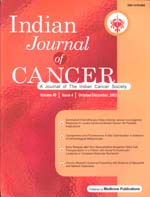
|
Indian Journal of Cancer
Medknow Publications on behalf of Indian Cancer Society
ISSN: 0019-509X
EISSN: 0019-509X
Vol. 42, No. 4, 2005, pp. 191-196
|
 Bioline Code: cn05034
Bioline Code: cn05034
Full paper language: English
Document type: Research Article
Document available free of charge
|
|
|
Indian Journal of Cancer, Vol. 42, No. 4, 2005, pp. 191-196
| en |
High resolution computed tomography findings on the lung of early breast-cancer patients treated by postoperative breast irradiation with a hypofractionated radiotherapy schedule
Plataniotis GA, Theofanopoulou ME, Sotiriadou K, Vlychou M, Fountoulis GA, Fezoulidis J
Abstract
Background: Hypofractionated breast radiotherapy (RT), although convenient for patients and health care systems, could have a negative impact on normal tissues such as lung.
Aims: To evaluate radiation-induced lung toxicity in early breast-cancer patients treated by hypofractionated RT.
Settings and Design: We have been using the 42.5 Gy/16 fractions RT schedule since May 2003. As large fraction size is related to increased normal tissue toxicity we intended to investigate the possible radiation-induced lung toxicity to these patients, by performing high-resolution computed tomography (HRCT) 6 months after the completion of the treatment.
Methods and Material: A group of 30 consecutive early breast cancer patients (T1-2N0M0) have been treated by the above-mentioned RT schedule, using a pair of opposing tangential fields. The impact of chemotherapy and hormonotherapy and various breast size-related parameters on HRCT lung changes were investigated. Acute skin and breast tissue reactions were also recorded.
Statistical analysis: used Correlation of numerical variables was investigated by Pearson correlation coefficient. Logistic regression analysis was used to investigate correlation between HRCT findings (present vs absent) with other variables.
Results: Minimal HRCT findings were evident in 15/30 patients. These included small septal lines, linear and subpleural opacities and to a lesser extend, focal-ground glass opacification. The HRCT findings were positively correlated only to field separation (distance between the entrance points of the tangential beams on the breast) (H.R.=1.33, 95% CI: 1.013-1.75).
Conclusions: The short 16-fraction RT schedule for early breast-cancer patients appears to have a minor effect on the underlying lung parenchyma.
Keywords
breast cancer; high resolution computed tomography; hypofractionation; lung changes; radiotherapy
|
| |
© Copyright 2005 Indian Journal of Cancer.
Alternative site location: http://www.indianjcancer.com/
|
|
